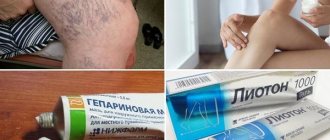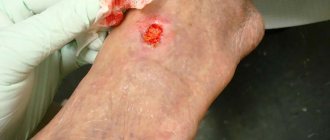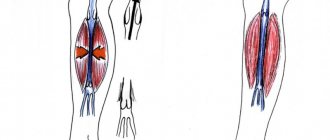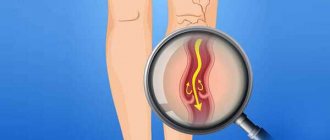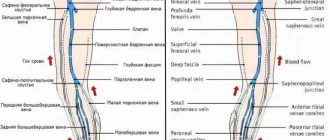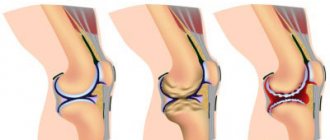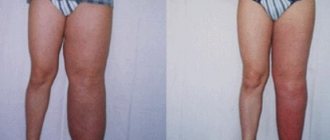Physiotherapist
Biryukova
Svetlana Alexandrovna
Experience 27 years
Physiotherapist of the highest qualification category
Make an appointment
The inflammatory process that develops in the tissues of the internal venous membranes and is accompanied by partial or complete thrombosis of damaged areas of blood vessels is called thrombophlebitis. As a rule, the disease first affects the veins of the lower extremities that run close to the skin (superficial). If left untreated, the process gradually spreads to the deep venous vessels. If in the acute period the patient does not receive proper treatment, the inflammation becomes chronic with remissions and relapses, but often chronicity occurs even with timely therapy.
Features and reasons for development
Under certain conditions, the inflammatory process affects the walls of blood vessels of any location, but in the vast majority of cases the disease affects the veins of the lower extremities, and primarily the superficial vessels deformed by varicose veins. Deep veins, along with superficial ones, become inflamed in approximately 10% of patients. The clinical picture is formed under the influence of a number of factors: an increase in the blood clotting index under the influence of changes in its composition, blood flow speed, the presence of deformations or damage to the vascular wall, etc.
The causes of thrombophlebitis include:
- genetic predisposition factor;
- varicose veins, which leads to stagnation of blood in the veins of the legs;
- wound or injury of the lower limb, accompanied by a purulent process;
- postoperative recovery period (including after medical abortion);
- postpartum period;
- long stay of the catheter in the vein;
- bed rest or immobility of the patient;
- dehydration of the body;
- age after 40 years.
The development of the inflammatory process is promoted by any disease or condition associated with decreased immunity.
Treatment of thrombophlebitis of the lower extremities.
Among vascular diseases, thrombophlebitis of the lower extremities occupies a special place due to particularly severe consequences. The pathology itself consists in the occurrence of an inflammatory process directly in the venous wall. This leads to the formation of a blood clot (thrombus) in the lumen of the vein.
In addition to the fact that the clot interferes with normal blood circulation and nutrition of surrounding tissues, there is a danger of its rupture. The consequences in this case are unpredictable; it is impossible to predict the exact movement. One of the biggest threats is blockage of large, major vessels, which is deadly. But with timely contact with a phlebologist, treatment of thrombophlebitis of the lower extremities is quite successful!
Causes and symptoms
The main cause of thrombophlebitis is varicose veins. In fact, thrombophlebitis is a complication of varicose veins, in which the speed of blood flow decreases. As a result, blood stagnation occurs, which contributes to the formation of a blood clot. Other causes of the disease include:
- long forced stay in one stationary position (after injuries, operations);
- hereditary factor (genetic predisposition);
- frequent air travel (pressure changes and long stays in one position have an effect);
- pregnancy, postpartum period;
- taking hormonal medications;
- venous catheterization;
- vascular injuries;
- increased blood clotting (coagulopathy, thrombophilia);
- weak immunity.
At the initial stage, symptoms of thrombophlebitis of the lower extremities rarely appear. But as the disease progresses, the patient complains of pain along the affected vessel. When palpated, a thickening is detected; the skin around the vein is distinctly red. With acute development, there is swelling of the limb and the temperature rises.
Diagnosis and treatment
Of the diagnostic techniques, ultrasound scanning of veins (ultrasound, angioscanning) is characterized by high reliability. Good results are demonstrated by Doppler ultrasound and MRI. The choice of diagnostic procedure should be made by a doctor. He, guided by the diagnostic results, prescribes treatment for thrombophlebitis, taking into account the individual characteristics of the patient. In the fight against this pathology, both conservative medicine (drug therapy, wearing compression stockings, nutritional recommendations) and surgical methods (phlebectomy) are used.
The professionalism of the doctor plays a key role in defeating thrombophlebitis. Many years of successful experience of our phlebologists, coupled with their constant training, brings excellent results. Visit our clinic - we will help you regain your health!
How to recognize the disease
Symptoms of thrombophlebitis are pronounced if the disease occurs in an acute form and is localized in the superficial veins. It is easy to recognize by:
- acute pain concentrated along the inflamed saphenous vein;
- redness, swelling, increased temperature in the area of the inflamed area of the vessel;
- swelling of the vein, which is clearly visible on the surface of the skin;
- the presence of seals in some parts of the vein in places of thrombosis;
- a general increase in body temperature, but not higher than 37.5-38°C;
- swelling of the soft tissues of the limb.
The elevated temperature lasts for several days, then subsides regardless of the condition of the limb, and other pronounced signs of thrombophlebitis gradually disappear. Often, patients do not consult a doctor, limiting themselves to applying a soothing ointment to the affected area. However, refusal of qualified assistance is extremely dangerous, since if a blood clot breaks off, severe complications can develop in a very short time, from ischemic or gangrenous thrombophlebitis to pulmonary embolism. Under no circumstances should you massage the affected area of the vein, as in this case the risk of blood clot rupture increases significantly.
The inflammatory process that develops in the deep veins of the limb is especially dangerous. Most often, it is asymptomatic or with minor general signs of malaise, by which it is impossible to recognize and localize the disease. The risk of thrombosis increases if the superficial veins are affected by varicose veins, accompanied by insufficient function of the valves of the perforating veins that connect the superficial and deep vessels.
Are you experiencing symptoms of thrombophlebitis?
Only a doctor can accurately diagnose the disease. Don't delay your consultation - call
Symptoms of thrombophlebitis
Acute thrombophlebitis of the superficial veins is manifested by the following symptoms:
Pain along the affected vein
Thrombophlebitis is characterized by acute nagging pain along the affected vein.
Skin redness
The skin over the affected vein turns red - a red stripe appears. To the touch, there is a thickening along the vein.
Enlarged lymph nodes
There is an increase in the inguinal lymph nodes.
Temperature increase
The person feels unwell. An increase in temperature to 37.5-38°C may be observed.
Leg swelling
Swelling of the leg may occur.
Diagnostic methods
During the initial consultation, the doctor conducts a visual examination of the affected limb and collects an anamnesis, however, many important data necessary for diagnosing thrombophlebitis can only be determined with the help of instrumental studies:
- Ultrasound of superficial vessels to determine the extent and location of blood clots;
- Doppler ultrasound to identify the characteristics of blood flow in the vessels of the limb;
- rheovasography, which helps to identify disturbances in the blood supply to tissues and organs;
- Ultrasound duplex scanning of veins is the most informative study that allows you to determine all important diagnostic indicators - the speed and direction of blood flow, the condition of the venous wall, the level of preservation of the vein lumen, etc.
In addition, the doctor prescribes general laboratory tests to clarify the patient’s general health, and a coagulogram to determine blood clotting indicators and the tendency to form blood clots. Additional studies may be prescribed according to indications.
How to treat
To treat thrombophlebitis, modern medicine uses various methods, from drug therapy to surgical intervention, depending on the severity of the disease and its stage. Most patients are usually prescribed conservative therapy, the goal of which is to stop the inflammatory process and reduce the risk of vascular thrombosis. For this purpose, the doctor prescribes:
- anti-inflammatory non-steroidal drugs;
- anticoagulant medications;
- enzyme therapy;
- treatment with phlebotonics;
- local compresses and ointments;
- in the presence of a purulent process - antibiotic therapy.
The patient is prescribed bed rest, but he can be treated at home if there is no risk of complications. Mechanical support of the blood vessels is important: it is necessary to bandage the affected limb with an elastic bandage and/or wear special compression garments. If there is a risk of disease progression and transition to deep veins, surgical removal of the thrombosed vessel is prescribed.
Diseases of the veins of the lower extremities: varicose veins, phlebitis, thrombophlebitis, thrombosis.
In addition to varicose veins, diseases of the veins of the lower extremities include quite a few diseases.
The causes of diseases of the veins of the lower extremities can be different. However, all diseases appear as a result of poor nutrition, poor lifestyle, bad habits, difficult working conditions, hormonal disorders or heredity.
The symptoms of vein diseases are similar.
Establishing a correct diagnosis is very important. The treatment of each disease of the veins of the lower extremities has a number of fundamental differences.
Among the diseases of the veins of the lower extremities, phlebologists name varicose veins, phlebitis, thrombophlebitis, thrombosis, trophic ulcers, chronic venous insufficiency, thromboembolism, etc.
Varicose veins
- This is varicose veins. Most often, varicose veins affect the lower extremities. Varicose veins are lesions of the venous walls. With the development of varicose veins, the walls of the veins are damaged, they become thinner and expand due to impaired blood flow. Varicose veins lead to decreased tone of the venous walls and valve insufficiency. As a result of pathological processes, venous outflow becomes more difficult, and the lumen in the veins increases. The valves are subject to deformation, their walls become thicker and shorter.
The reasons for the development of varicose veins, as a rule, are heredity, excess body weight, severe prolonged tension in the legs, physical inactivity or a sedentary lifestyle, a sedentary lifestyle, in women, pregnancy and childbirth, hormonal imbalance, bad habits (alcohol, smoking, drugs), long-term use of medications and hormonal drugs.
Varicose veins can be recognized by the following symptoms, which are characteristic of all diseases of the veins of the lower extremities:
- swelling of the legs, worsening in the evening;
- heaviness in the legs;
- bursting sensation in the calves;
- bulging veins.
With vigorous activity or during sleep, symptoms become less obvious.
However, the disease develops, and the symptoms become more pronounced: pain, heat in the lower extremities, and cramps appear. Telangiectasias appear on the skin.
A phlebologist at the Only Clinic conducts a phlebological examination: examines the patient and prescribes diagnostic measures, including duplex scanning and contrast venography.
The treatment prescribed by the Only Clinic phlebologist depends on the results of the phlebological examination.
As a rule, phlebological treatment of varicose veins in Nizhny Novgorod includes the use of medications, traditional medicine, physical therapy, wearing compression garments and surgical methods.
Drug treatment
varicose veins in the Only Clinic involves the use of drugs that strengthen vascular walls and thin the blood, for example phlebotonics, anticoagulants, venotonics, non-steroidal anti-inflammatory drugs.
Phlebologists at Only Clinic also recommend using local medications (ointments) to relieve pain and swelling.
At stages 3 and 4 of varicose veins, the only effective treatment is surgery.
Surgical operations for the treatment of varicose veins performed at Only Clinic include:
- sclerotherapy is when the inflamed vein is resolved with the help of a special sclerosant preparation;
- laser therapy is a procedure to turn off a diseased vein from the bloodstream using a laser beam;
- classic phlebectomy is the removal of a vein under anesthesia.
Phlebitis
- This is an inflammatory process of the walls of the veins.
Phlebitis usually develops against the background of varicose veins of the lower extremities. The inflammatory process leads to impaired blood flow and the formation of blood clots. Untreated phlebitis can lead to a more dangerous disease - thrombophlebitis.
Symptoms of the development of phlebitis are pain; skin redness; temperature increase; general weakness; swelling.
Phlebitis can become chronic. In the chronic form, the symptoms of phlebitis either subside, going into remission, or sharply worsen.
Treatment of phlebitis, as a rule, is quite lengthy and consists of several stages and must be comprehensive.
In the initial stage of phlebitis, hospitalization is not required.
If the disease is advanced, then the patient with phlebitis must be hospitalized.
While in the hospital, the patient undergoes a series of procedures. The patient is prescribed bed rest, while the patient's legs should be at rest and at some elevation.
To treat phlebitis, a phlebologist prescribes drugs that strengthen the walls of the veins, reduce blood density and eliminate inflammation.
After the acute phase of the disease and exacerbation are removed, the patient is prescribed to wear compression garments and bandage the legs with an elastic bandage.
Without fail, in order to relapse phlebitis, the phlebologist prescribes a diet and medication to reduce cholesterol in the blood.
Thrombophlebitis develops as
complication of varicose veins. Thrombophlebitis is characterized by an inflammatory process on the walls of the veins and the formation of blood clots.
The most common site of localization of the disease is the lower extremities (from the lower part of the buttocks to the lower part of the lower leg).
The causes of thrombophlebitis can be excess body weight, pregnancy, injury, some kind of virus, heredity, sedentary lifestyle, physical inactivity, diabetes, overheating.
Thrombophlebitis usually develops against the background of untreated phlebitis.
Thrombophlebitis can be recognized by the following symptoms. This is severe pain in the calf muscles, general malaise, high body temperature, redness of the skin, skin thickening, weakness in the lower extremities, a feeling of coldness in the toes, limping when walking.
Thrombophlebitis can develop rapidly: body temperature can suddenly and sharply rise to 38 - 39 degrees. Severe pain and redness of the skin are observed in the vein area.
Typically, this acute phase of thrombophlebitis lasts for 10-30 days.
After this, the disease thrombophlebitis becomes chronic.
Treatment of thrombophlebitis in Nizhny Novgorod must begin as early as possible, at the first symptoms.
To get rid of thrombophlebitis in a modern private medical clinic, as a rule, drug therapy or surgery is prescribed.
A patient with thrombophlebitis takes medications on an outpatient basis if the blood clot has not spread beyond the lower leg. If the disease is caused by injury to the venous wall, anticoagulants or an alcohol compress are used. Also, the phlebologist at the Only Clinic prescribes anti-inflammatory drugs to the patient.
Phlebologists usually include the following medications in the course of treatment for thrombophlebitis: phlebotonics (Detralex, Venosmin); angioprotectors (rutin derivatives); non-steroidal anti-inflammatory drugs (Sinmeton, Diclofenac, Meloxicam); anticoagulants (Warfarin, Sinkumar).
Surgical treatment of thrombophlebitis must be resorted to if the disease has spread to the deep veins, as well as if there is a risk of complications.
Surgical methods for treating thrombophlebitis include ligation of pathological vessels; thrombectomy (removal of a blood clot); phlebectomy (removal of veins affected by the pathological process).
Thrombosis
Phlebologists diagnose if there is a violation of the inner surface of the venous wall of the deep veins.
Phlebologists name the reasons for the development of thrombosis as infection, chemical or mechanical damage to the veins, as well as an allergic reaction.
The risk of thrombosis increases greatly if there is high blood clotting or congestion in the veins of the lower extremities due to low physical activity or prolonged standing.
IMPORTANT! Physical inactivity is the main factor leading to thrombosis!
When a person sits in a sitting position with bent legs for many hours, blood stagnates in the deep veins, which provokes the development of thrombosis.
Causes of blockage of blood vessels: increased blood viscosity due to a lack of fluid in the body, as well as as a result of metabolic disorders or the effects of a malignant tumor, stagnation of blood in the legs resulting from physical inactivity, varicose veins or inflammatory disease, pathology of the circulatory system (thrombophlebitis, erythremia) , genetic factor, infectious diseases (sepsis, allergies), pneumonia, obesity, diabetes.
At the initial stage, the symptoms of thrombosis are usually mild. However, over time, more and more signs of thrombosis appear, including: swelling of the lower extremities, formations in the form of spider veins, discoloration of the skin on the legs, cramps, especially disturbing at night, pain in the thigh, lower leg and foot (pain subsides with horizontal location of the limb), venous insufficiency, elevated body temperature.
In the acute stage, thrombosis proceeds rapidly: venous outflow completely or partially stops; thighs and legs increase in size; the saphenous veins dilate noticeably; cyanosis occurs; body temperature rises to 38 degrees.
The choice of treatment tactics for thrombosis at the Center for Modern Medicine Only Clinic depends on the stage of the disease, the general health of the patient, and the location of the pathology.
The main goal in treating thrombosis is to stop the spread of thrombosis, as well as to prevent pulmonary embolism (that is, blockage of the arteries of the lungs). Treatment is carried out only in a hospital setting.
A patient with thrombosis is prescribed strict bed rest and medications, including anticoagulants, thrombolytic and fibrinolytic drugs, as well as antiplatelet agents.
Surgery to remove thrombosis is performed if the patient’s life is threatened.
Treatment methods for deep vein thrombosis:
Drug therapy: Medications are prescribed to reduce symptoms and normalize blood flow. As a rule, a phlebologist prescribes coagulants (Coumadin, Heparin, Warfarin) to reduce blood thickness and prevent thrombosis in the vessels and veins of the legs, as well as reduce swelling.
Also, to eliminate thrombosis, it is necessary to take thrombolytic agents (Trypsin, Chymotrypsin) and phlebotonics.
Surgical treatment of thrombosis is indicated when there is a risk of thrombus rupture.
Surgery is contraindicated at the stage of exacerbation of the disease and in certain cardiovascular pathologies.
The use of traditional medicine is useful to prevent the development of thrombosis. Phlebologists recommend the use of herbal tinctures and foot baths based on nettle, horse chestnut, and chamomile.
Phlebologists at Only Clinic can also recommend moderate exercise, including walking and therapeutic exercises, for patients with thrombosis.
If thrombosis is diagnosed, the patient is strictly prohibited from activities with high stress on the feet, as well as thermal procedures (sauna, steam bath, hot baths).
A consultation appointment on the problems of varicose veins, thrombosis or phlebitis at the Only Clinic costs 1,200 rubles.
Examination by a phlebologist, including ultrasound of the veins of the lower extremities - 2100 rubles.
Call! We will help!
How to prevent further development of the disease
Measures to prevent thrombophlebitis are equally effective both for those who have already suffered from an acute form of the disease and for people who are at risk of developing inflammation of the veins. These include:
- constantly wearing compression hosiery or supporting veins with elastic bandaging;
- proper organization of work and rest;
- moderate physical activity on the legs, providing support for the function of venous valves and preventing the progression of varicose veins;
- following a special diet;
- providing regular unloading for the legs in the form of a lying position with the legs raised above the body.
If these rules are followed, the risk of thrombophlebitis is significantly reduced.

